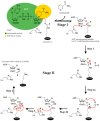A Molecular Perspective on Sirtuin Activity
- PMID: 33203121
- PMCID: PMC7696986
- DOI: 10.3390/ijms21228609
A Molecular Perspective on Sirtuin Activity
Abstract
The protein acetylation of either the α-amino groups of amino-terminal residues or of internal lysine or cysteine residues is one of the major posttranslational protein modifications that occur in the cell with repercussions at the protein as well as at the metabolome level. The lysine acetylation status is determined by the opposing activities of lysine acetyltransferases (KATs) and lysine deacetylases (KDACs), which add and remove acetyl groups from proteins, respectively. A special group of KDACs, named sirtuins, that require NAD+ as a substrate have received particular attention in recent years. They play critical roles in metabolism, and their abnormal activity has been implicated in several diseases. Conversely, the modulation of their activity has been associated with protection from age-related cardiovascular and metabolic diseases and with increased longevity. The benefits of either activating or inhibiting these enzymes have turned sirtuins into attractive therapeutic targets, and considerable effort has been directed toward developing specific sirtuin modulators. This review summarizes the protein acylation/deacylation processes with a special focus on the current developments in the sirtuin research field.
Keywords: lysine deacetylases; posttranslational modifications; protein acylation; sirtuins.
Conflict of interest statement
The authors declare no conflict of interest. The funders had no role in the design of the study; in the collection, analyses, or interpretation of data; in the writing of the manuscript, or in the decision to publish the results.
Figures




References
-
- Roth M.J., Forbes A.J., Boyne M.T., 2nd, Kim Y.B., Robinson D.E., Kelleher N.L. Precise and parallel characterization of coding polymorphisms, alternative splicing, and modifications in human proteins by mass spectrometry. Mol. Cell. Proteom. 2005;4:1002–1008. doi: 10.1074/mcp.M500064-MCP200. - DOI - PMC - PubMed
Publication types
MeSH terms
Substances
LinkOut - more resources
Full Text Sources
Medical

